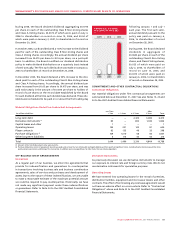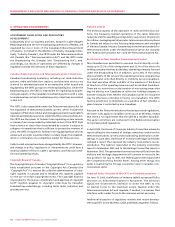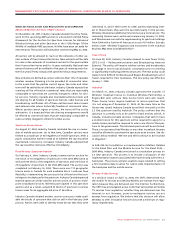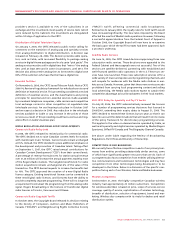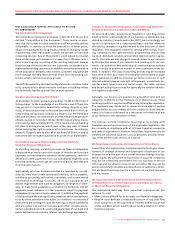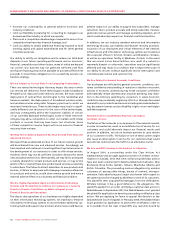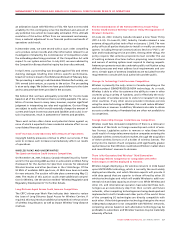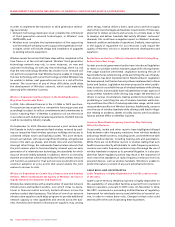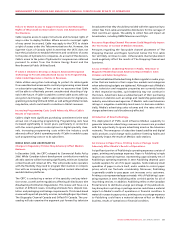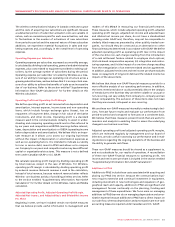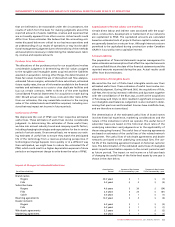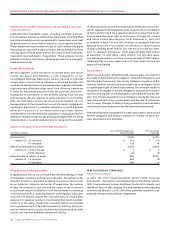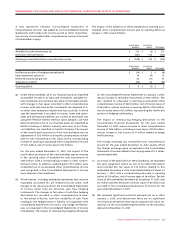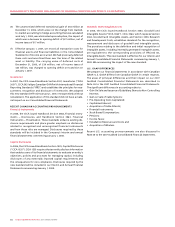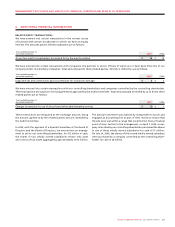Rogers 2007 Annual Report Download - page 63
Download and view the complete annual report
Please find page 63 of the 2007 Rogers annual report below. You can navigate through the pages in the report by either clicking on the pages listed below, or by using the keyword search tool below to find specific information within the annual report.
ROGERS COMMUNICATIONS INC. 2007 ANNUAL REPORT 59
MANAGEMENT’S DISCUSSION AND ANALYSIS OF FINANCIAL CONDITION AND RESULTS OF OPERATIONS
Failure to Obtain Access to Support Structures and Municipal
Rights of Way Could Increase Cable’s Costs and Adversely Affect
Our Business.
Cable requires access to support structures and municipal rights of
way in order to deploy facilities. Where access to municipal rights
of way cannot be secured, Cable may apply to the CRTC to obtain
a right of access under the Telecommunications Act. However, the
Supreme Court of Canada ruled in 2003 that the CRTC does not
have the jurisdiction to establish the terms and conditions of access
to the poles of hydroelectric companies. As a result of this decision,
Cable’s access to the poles of hydroelectric companies are obtained
pursuant to orders from the Ontario Energy Board and the
New Brunswick Public Utilities Board.
If Cable is Unable to Develop or Acquire Advanced Encryption
Technology to Prevent Unauthorized Access to Its Programming,
Cable Could Experience a Decline in Revenues.
Cable utilizes encryption technology to protect its cable signals
from unauthorized access and to control programming access based
on subscription packages. There can be no assurance that Cable
will be able to effectively prevent unauthorized decoding of sig-
nals in the future. If Cable is unable to control cable access with our
encryption technology, Cable’s subscription levels for digital pro-
gramming including VOD and SVOD, as well as Rogers Retail rentals,
may decline, which could result in a decline in Cable’s revenues.
Increasing Programming Costs Could Adversely Affect Cable’s
Results of Operations.
Cable’s single most significant purchasing commitment is the total
annual cost of acquiring programming. Programming costs have
increased significantly in recent years, particularly in connection
with the recent growth in subscriptions to digital specialty chan-
nels. Increasing programming costs within the industry could
adversely affect Cable’s operating results if Cable is unable to pass
such programming costs on to its subscribers.
MEDIA RISKS AND UNCERTAINTIES
Changes in Regulatory Policies May Adversely Affect Media’s
Business.
In December 2006, the CRTC released its Commercial Radio Policy
2006. While Canadian talent development contributions made by
all radio stations will be increasing significantly, minimum Canadian
content levels will remain at 35%. This will provide radio operators
with the flexibility they need to program their stations in competi-
tion with an increasing array of unregulated content alternatives
and distribution platforms.
The CRTC is conducting a review of the specialty and pay televi-
sion sector, as well as the regulations affecting all distributors (the
Broadcasting Distribution Regulations). This review will focus on a
number of different issues, including wholesale fees, dispute reso-
lution and packaging and linkage requirements. This broad-based
review will impact all specialty services, including Rogers Sportsnet,
The Biography Channel Canada and G4TechTV Canada. The pro-
ceeding will also examine the argument put forward by television
broadcasters that they should be provided with the opportunity to
collect fees from cable and satellite distributors for the carriage of
their over-the-air signals. The ability to collect fees will impact all
broadcasters, including OMNI Television and Citytv.
Pressures Regarding Channel Placement Could Negatively Impact
the Tier Status of Certain of Media’s Channels.
Pressures regarding the favourable channel placement of The
Shopping Channel and Rogers Sportsnet below the first cable
tier will likely continue to exist. Unfavourable channel placement
could negatively affect the results of The Shopping Channel and
Sportsnet.
A Loss in Media’s Leadership Position in Radio, Television or
Magazine Readership Could Adversely Impact Media’s Sales
Volumes and Advertising Rates.
It is well established that advertising dollars migrate to media prop-
erties that are leaders in their respective markets and categories
when advertising budgets are tightened. Although most of Media’s
radio, television and magazine properties are currently leaders
in their respective markets, such leadership may not continue in
the future. Advertisers base a substantial part of their purchasing
decisions on statistics such as ratings and readership generated by
industry associations and agencies. If Media’s radio and television
ratings or magazine readership levels were to decrease substan-
tially, Media’s advertising sales volumes and the rates which it
charges advertisers could be adversely affected.
Introduction of New Technology.
The deployment of PVRs could influence Media’s capability to
generate television advertising revenues as viewers are provided
with the opportunity to ignore advertising aired on the television
networks. The emergence of subscriber-based satellite and digital
radio products could change radio audience listening habits and
negatively impact the results of Media’s radio stations.
An Increase in Paper Prices, Printing Costs or Postage Could
Adversely Affect Media’s Results of Operations.
A significant portion of Publishing’s operating expenses consists of
paper, printing and postage expenses. Paper is Publishing’s single
largest raw material expense, representing approximately 8% of
Publishing’s operating expenses in 2007. Publishing depends upon
outside suppliers for all of its paper supplies, holds relatively small
quantities of paper in stock itself, and is unable to control paper
prices, which can fluctuate considerably. Moreover, Publishing
is generally unable to pass paper cost increases on to customers.
Printing costs represented approximately 14% of Publishing’s oper-
ating expenses in 2007. Publishing relies on third parties for all of
its printing services. In addition, Publishing relies on the Canadian
Postal Service to distribute a large percentage of its publications.
Any disruption in printing or postage services could have a material
impact on Media’s results of operations or financial condition. A
material increase in paper prices, printing costs or postage expenses
to Publishing could have a material adverse effect on Media’s
business, results of operations or financial condition.


